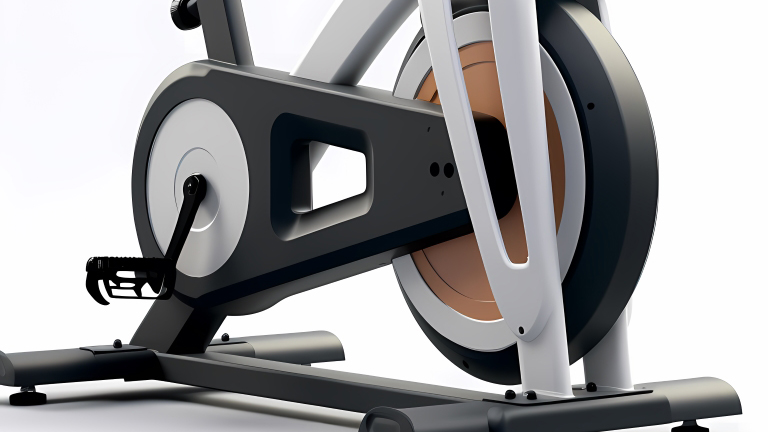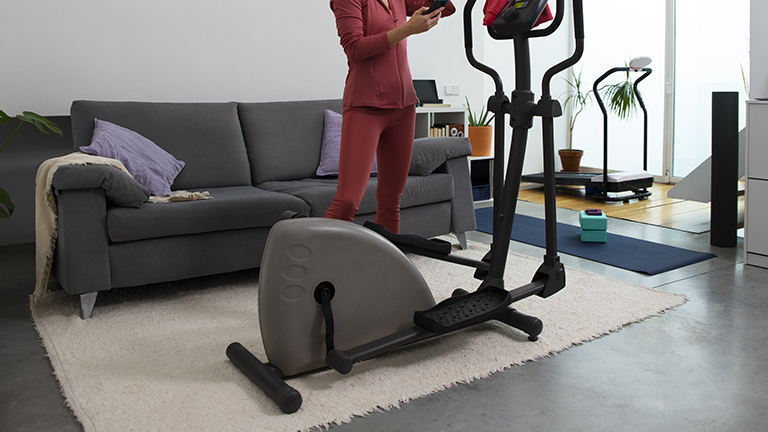Knee replacement surgery can significantly impact mobility and quality of life. Post-surgery rehabilitation is essential for regaining strength, flexibility, and overall function in the knee joint. One of the safest and most effective methods to aid recovery is using an exercise bike. Exercise bikes provide low-impact movement, allowing patients to gently strengthen muscles around the knee without causing excessive strain or discomfort. They also improve circulation, promote joint lubrication, and enhance cardiovascular fitness, all of which contribute to a faster, safer recovery. Incorporating a well-chosen exercise bike into your rehabilitation routine can help restore independence and prevent long-term stiffness or complications, making it a cornerstone of post-knee replacement therapy.
How an Exercise Bike Helps in Recovery
An exercise bike is a highly effective tool for knee replacement recovery due to its low-impact nature, which minimises stress on the healing joint while promoting mobility. Cycling encourages smooth, continuous motion, helping to restore range of motion and strengthen surrounding muscles such as the quadriceps, hamstrings, and calves. Additionally, using an exercise bike enhances blood circulation, which supports tissue healing and reduces swelling. It also allows for controlled, gradual resistance adjustments, enabling patients to start with gentle workouts and progressively increase intensity. Beyond physical benefits, regular exercise on a bike improves cardiovascular health, aids weight management, and boosts mental well-being, all of which contribute to a more successful and faster rehabilitation process.
Types of Exercise Bikes for Knee Replacement
Recumbent Exercise Bikes
Recumbent bikes feature a reclined seating position that offers excellent back support and reduces stress on the knees. The ergonomic design ensures a natural pedaling motion, making it ideal for post-surgery recovery.
Upright Exercise Bikes
Upright bikes resemble traditional bicycles and provide a more intense workout. While they offer cardiovascular benefits, users must adjust the seat and handlebar positions to ensure knee comfort and avoid strain.
Semi-Recumbent and Hybrid Bikes
Semi-recumbent and hybrid bikes combine features from both recumbent and upright models. They offer adjustable resistance, ergonomic seating, and easy access, making them suitable for patients in different stages of knee recovery.
Key Features to Look for in a Knee-Friendly Exercise Bike
Adjustable Resistance Levels
Post-surgery, it is important to start with low resistance and gradually increase intensity. Exercise bikes with adjustable resistance allow patients to customize their workout according to their comfort and rehabilitation needs.
Comfortable Seating and Ergonomics
A well-cushioned seat, adjustable height, and back support are crucial. Proper seating reduces knee strain, encourages proper posture, and enhances overall workout experience.
Step-Through Frame for Easy Access
Step-through frames make it easier for patients to mount and dismount the bike without putting unnecessary stress on the knees. This feature is especially beneficial for seniors or those with limited mobility.
Smooth Pedaling Motion
A bike with a smooth, quiet pedaling mechanism minimizes joint impact and promotes consistent knee movement. Magnetic resistance or belt-driven systems are ideal for a seamless cycling experience.
[INSERT_ELEMENTOR id=”5108″]
Top 5 Exercise Bikes for Knee Replacement
| Bike Model | Type | Key Features | Price | Rating |
| Schwinn 270 Recumbent Bike | Recumbent | Adjustable resistance, LCD display, comfortable seat | $699 | 4.8/5 |
| Nautilus U618 Upright Bike | Upright | Multiple resistance levels, heart rate monitoring, ergonomic seat | $799 | 4.7/5 |
| Exerpeutic 900XL Recumbent Bike | Recumbent | Easy step-through, smooth pedaling, affordable | $349 | 4.6/5 |
| Marcy Recumbent Exercise Bike ME-709 | Recumbent | Compact design, adjustable seat, silent operation | $299 | 4.5/5 |
| Diamondback 510Sr Recumbent Bike | Semi-Recumbent | Multiple workout programs, adjustable resistance, back support | $999 | 4.8/5 |
Detailed Reviews of Each Model
Schwinn 270 Recumbent Bike: Ideal for seniors and post-surgery patients, this bike offers 25 resistance levels and pre-programmed workouts for gradual rehabilitation. Its LCD screen tracks distance, calories, and heart rate.
Nautilus U618 Upright Bike: Suitable for advanced rehabilitation stages, the upright position enhances cardiovascular endurance while protecting knee joints. The ergonomic seat and multiple resistance settings ensure comfort.
Exerpeutic 900XL Recumbent Bike: Budget-friendly with essential features for post-knee surgery recovery. It provides a step-through frame and smooth pedal motion, making it perfect for gentle cycling.
Marcy Recumbent Exercise Bike ME-709: Compact and quiet, this bike is great for home use. Its adjustable seat and ergonomic design ensure minimal knee strain while providing effective cardiovascular exercise.
Diamondback 510Sr Recumbent Bike: Premium option with advanced features like multiple resistance levels and programmed workouts. It offers excellent back support, making it suitable for long-duration rehabilitation sessions.
Tips for Using an Exercise Bike Safely Post-Surgery
Recommended Duration and Intensity
Start with 5-10 minutes per session and gradually increase to 20-30 minutes. Keep resistance low initially and slowly increase as your knee strength improves.
Warm-Up and Cool-Down Exercises
Perform gentle stretching before and after cycling to reduce stiffness and improve flexibility. Focus on quadriceps, hamstrings, and calf stretches.
Listening to Your Body and Avoiding Pain
Stop immediately if you experience sharp pain or swelling. Mild discomfort is normal, but pain signals overexertion or improper positioning.
Physical Therapy Integration
Combining Bike Workouts with Knee Exercises
Exercise bikes should complement physical therapy routines. Incorporate strength training, balance exercises, and range-of-motion exercises to accelerate recovery.
When to Consult Your Physiotherapist
Always consult your physiotherapist before increasing intensity or duration. Personalized guidance ensures safe progression and prevents setbacks.
Common Mistakes to Avoid
Overexertion and Knee Strain
Pushing too hard can damage the healing joint. Gradual increase in resistance and duration is key.
Poor Bike Setup
Incorrect seat height or handlebar position can strain the knees. Ensure proper alignment to maintain comfort and prevent injury.
Expert Opinion Exercise Bike for Knee Replacement
Expert opinions consistently highlight the benefits of incorporating exercise bikes into knee replacement rehabilitation programs. Physical therapists often recommend stationary cycling as a foundational component of post-surgery recovery due to its low-impact nature and effectiveness in restoring knee function.
Physical Therapist Recommendations
According to Tim Fraticelli, DPT, a physical therapist, many patients can begin using an upright bike within two weeks of surgery, provided they have at least 100 degrees of knee flexion. He notes that cycling helps improve range of motion and strengthens muscles around the knee joint. PubMed Central
Dr. Adam Rosen, an orthopedic specialist, emphasizes that stationary biking is “the gold standard” for achieving and maintaining range of motion after knee replacement. He recommends starting with gentle pedal movements and gradually increasing intensity as comfort allows. YouTube
Clinical Insights
A systematic review published in the Journal of Rehabilitation Research and Development analyzed various rehabilitation programs after total knee arthroplasty (TKA). The study found that cycling-based rehabilitation led to comparable improvements in pain reduction, range of motion, and functional activities when compared to other therapeutic interventions. PubMed Central
Guidelines for Safe Cycling Post-Surgery
Experts suggest the following guidelines for incorporating cycling into knee replacement rehabilitation:
- Timing: Begin stationary cycling within two weeks post-surgery, depending on individual recovery progress.
- Resistance: Start with low resistance to avoid overstressing the knee joint.
- Duration: Aim for short sessions initially, gradually increasing as strength and endurance improve.
- Monitoring: Pay attention to any signs of pain or discomfort, adjusting the workout intensity accordingly.
Always consult with a healthcare professional before starting any new exercise regimen to ensure it aligns with your specific recovery needs.
Conclusion: Exercise Bike for Knee Replacement
Exercise bikes are essential tools for safe and effective knee replacement rehabilitation. Choosing the right type, understanding key features, and following a structured workout plan ensures optimal recovery. By integrating exercise bikes with physical therapy, patients can regain mobility, strengthen muscles, and enjoy long-term knee health. Investing in a quality recumbent or upright bike tailored to your needs enhances comfort, reduces strain, and promotes a smooth recovery journey.


